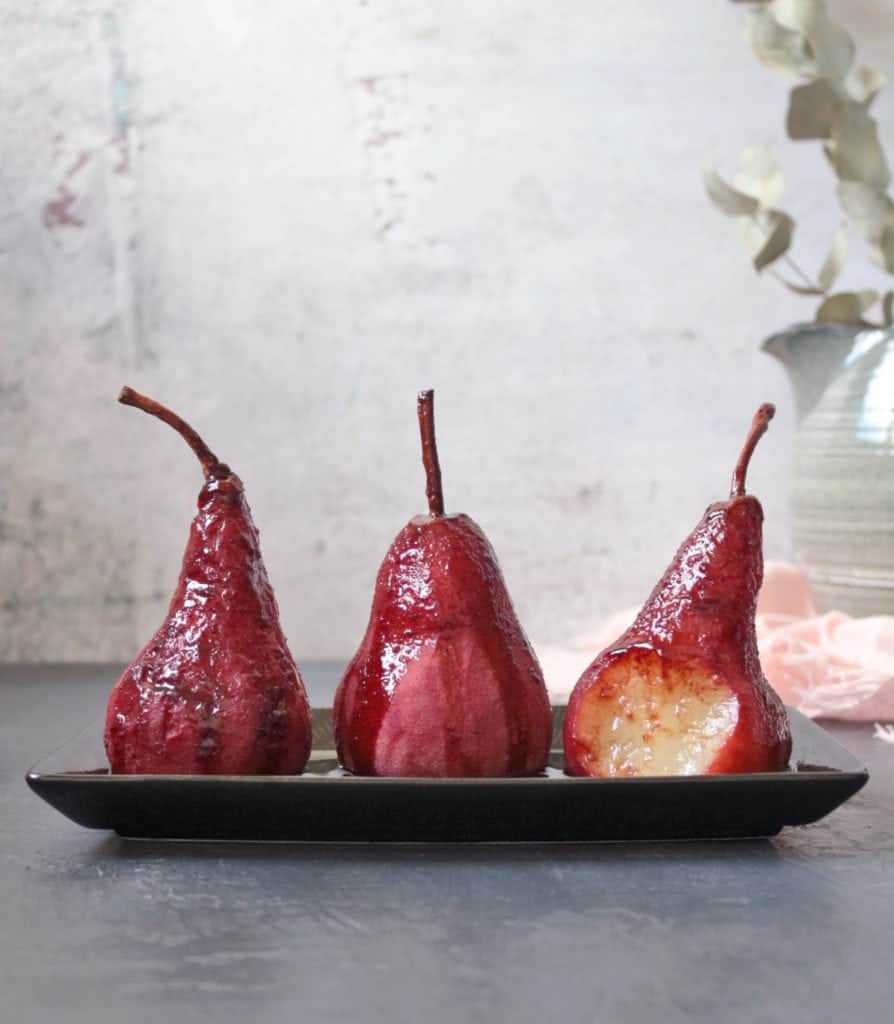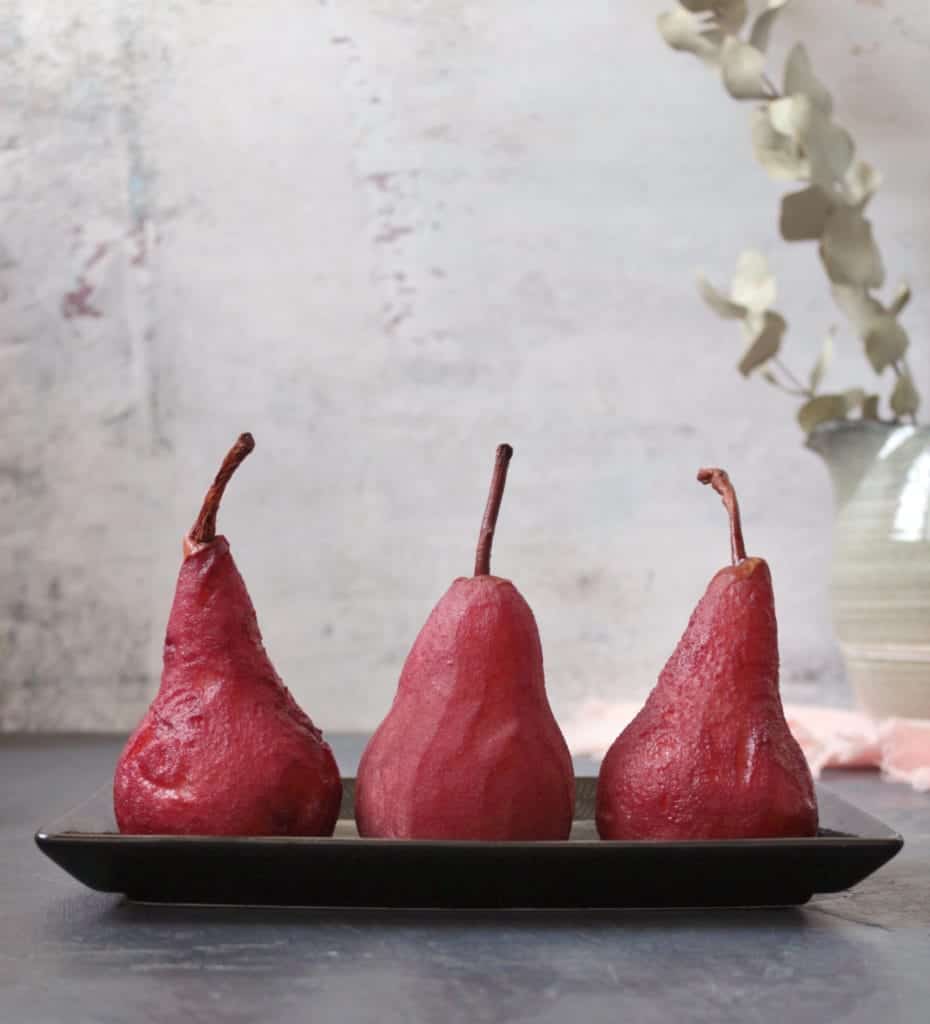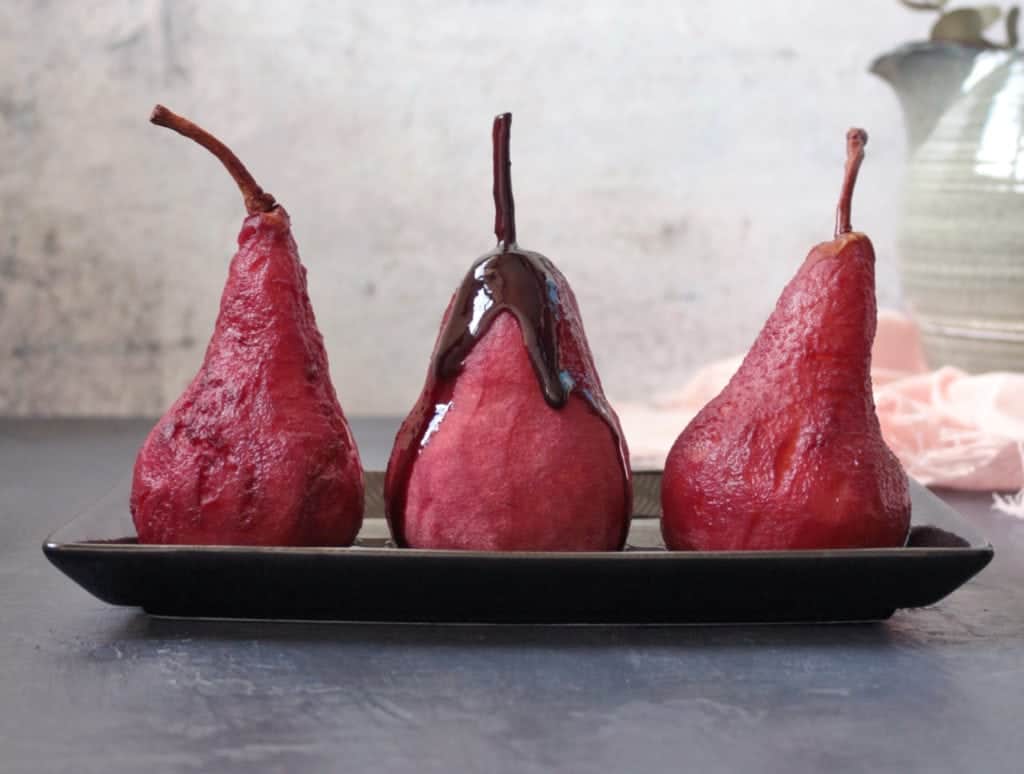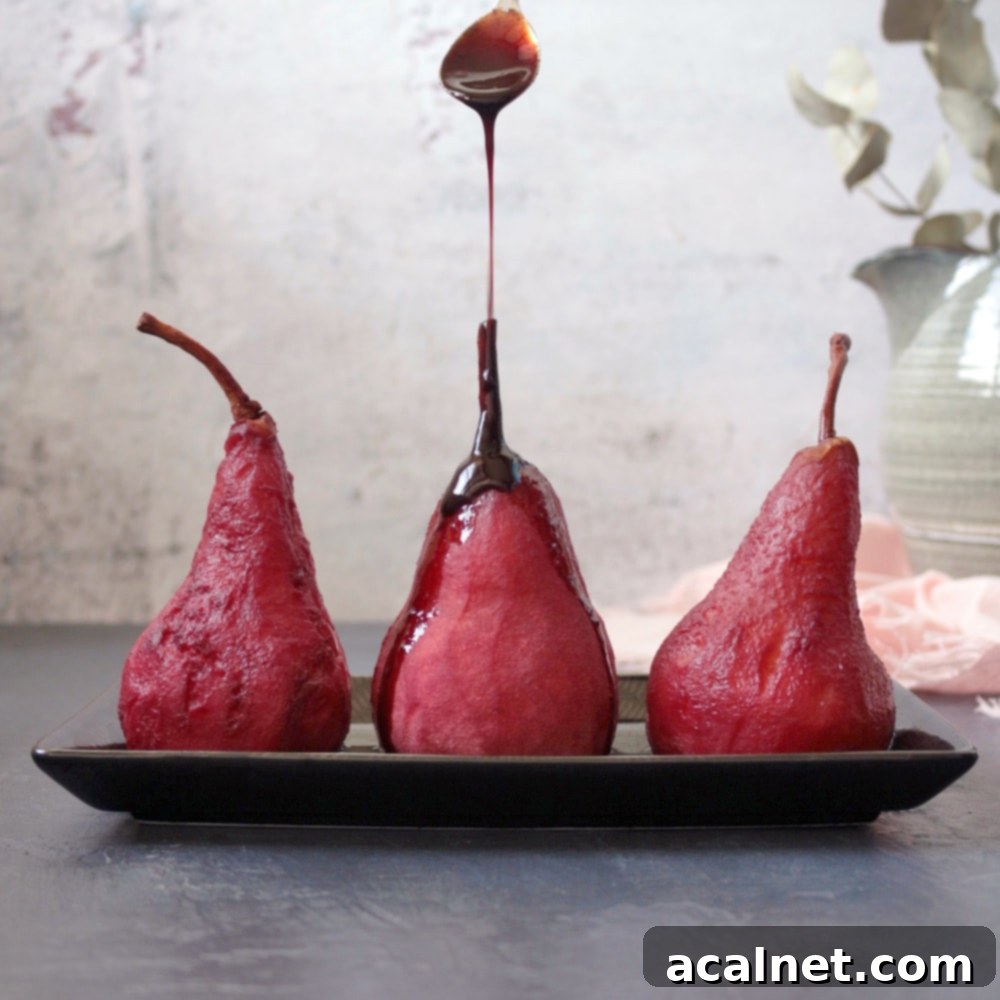Elegant Spiced Red Wine Poached Pears: Your Perfect Winter Dessert
Few desserts embody the warmth and comfort of the winter season quite like Red Wine Poached Pears. This classic French recipe transforms simple pears into a show-stopping, aromatic, and deeply flavorful treat. Poached gently in a fragrant mixture of red wine, aromatic spices, and bright citrus, these pears are not only incredibly easy to make but also serve as a sophisticated dessert perfect for any dinner party or holiday celebration. Plus, they offer the delightful bonus of being both vegan and gluten-free, catering to a wide range of dietary preferences.

Why You’ll Adore This Red Wine Poached Pear Recipe
Poached pears have a timeless elegance that makes them an instant show-stopper at any gathering. Originating from classic French cuisine, this dessert is celebrated for its simplicity and profound flavor. Beyond their beautiful presentation and delicious taste, these stewed pears or pear compote alternatives fill your home with an intoxicating aroma of spices and wine, creating an inviting atmosphere that truly signals the holiday season.
What truly sets this recipe apart is its incredible versatility. There’s no single “right” way to make poached pears; you have the freedom to customize the spices, citrus, and even the wine-to-water ratio to perfectly match your taste preferences. Whether you prefer a subtle hint of cinnamon or a bold burst of star anise, this recipe can be adapted to your liking. This adaptability makes it a fantastic canvas for culinary creativity, allowing you to craft a unique dessert every time.
Beyond being a standalone dessert, poached pears are also wonderfully versatile for other culinary creations. Imagine them nestled atop a delicate Pear Frangipane Tartlet, or transformed into a luxurious Red Wine Pear Tarte Tatin. Their tender texture and infused flavor make them an ideal component in more complex bakes, adding a touch of gourmet flair.
The choice of red wine and its proportion to water allows for further customization. For a deep, intense red wine flavor that truly shines, consider omitting the water entirely. If you prefer a lighter, more delicate dessert, increasing the water content will mellow the wine’s intensity. Our recipe provides a balanced approach, combining rich red wine with warm winter spices and zesty citrus notes, creating a harmonious and unforgettable experience. We’re confident it will become a cherished recipe in your kitchen!
Essential Ingredients for Spiced Poached Pears
The foundation of this delightful dessert, as the name suggests, lies in two key components: Red Wine and Pears. While you could technically poach pears in wine alone, the true magic unfolds with the strategic addition of aromatic spices and bright citrus. These extra ingredients elevate the flavor profile, transforming a simple fruit into a complex, comforting, and irresistibly fragrant treat.
To craft these exquisite Red Wine Poached Pears, you will need the following (Please refer to the detailed recipe card below for precise quantities):
- Pears: The star of the show! Selecting the right variety and ripeness is crucial for perfect poaching.
- Red Wine: The primary poaching liquid. Your choice of wine will significantly influence the final flavor.
- Water: Used to dilute the wine, allowing you to control the intensity of the wine flavor.
- Lemon Juice: Adds a touch of acidity and brightness, balancing the sweetness and rich wine notes.
- Brown Sugar: Provides sweetness and a molasses-like depth that complements the spices beautifully.
- Orange Peels: Infuses the poaching liquid with a zesty, aromatic citrus fragrance.
- Spices: A blend of warming spices like cinnamon, star anise, nutmeg, and ginger that define the “spiced” aspect of this dessert.

Mastering the Art of Poaching Pears in Red Wine
“Poaching” is a gentle cooking technique where an ingredient is cooked by submerging it in a simmering liquid. In this recipe, our liquid is a carefully crafted blend of red wine, water, and an array of flavor enhancers. This method is often favored for its ability to preserve the delicate texture and natural flavors of the food, and it’s particularly well-suited for fruits like pears.
Moreover, poaching is known as a healthier cooking method as it requires no added fats like butter or oil, allowing the natural goodness of the ingredients to shine through. Poaching pears in a spiced red wine liquid is not only simple but also incredibly rewarding, filling your kitchen with an inviting aroma.
Here’s a detailed breakdown of how to achieve perfectly poached pears:
- Prepare the Poaching Liquid: Begin by combining your chosen ingredients, including red wine, water, brown sugar, lemon juice, orange peels, and an assortment of warming spices (like cinnamon, star anise, nutmeg, and ginger) in a deep pot. Gently heat the mixture to a simmer, stirring occasionally until the brown sugar has fully dissolved. This creates a deeply fragrant and flavorful base for your pears.
- Prepare the Pears: Carefully peel the pears, leaving the stem intact for an elegant presentation. For stability in the pot, you might trim a thin slice off the bottom of each pear if necessary. Alternatively, you can slice the pears in half or quarters and remove the core for quicker cooking and easier serving, though the whole pear presentation is undeniably stunning.
- Poach to Perfection: Gently submerge the prepared pears into the simmering poaching liquid. Ensure they are mostly covered; if not, gently turn them periodically to ensure even cooking and absorption of flavor. Cook on a low to medium heat until the pears are tender but still retain their shape. This usually takes between 20 to 30 minutes, depending on the pear’s ripeness and variety. Remove the pears from the liquid once tender.
- Create a Rich Syrup (Optional but Recommended!): This step is where you elevate your dessert from delicious to truly extraordinary. Keep the remaining poaching liquid in the pot. Increase the heat and allow the liquid to reduce, simmering until it thickens into a glossy, intensely flavored syrup. Make sure to watch it closely to prevent burning. Strain the reduced syrup through a fine-mesh sieve to remove the spices and orange peels, resulting in a smooth, vibrant red wine syrup perfect for drizzling over your poached pears.

Frequently Asked Questions About Poached Pears
The poaching time for pears can vary significantly, typically ranging from 20 to 45 minutes. Several factors influence this: the specific variety of pear, its initial ripeness (firmer pears take longer), and the simmering temperature of your poaching liquid. For un-ripe, firm pears, expect approximately 20 to 30 minutes of simmering to achieve a tender texture while still allowing them to hold their beautiful shape. The best way to check for doneness is to gently pierce the pear flesh with the tip of a sharp knife; it should glide in easily with minimal resistance. Always keep a close eye on them to prevent them from becoming overly soft or mushy.
The secret to a perfect poached pear lies in choosing the right pear variety. You need a pear that is firm enough to hold its shape during the cooking process, even after simmering for a good 30 minutes. It should also have a relatively sweet flavor to complement the rich, spiced red wine. Excellent choices for poaching include: Bosc Pears (known for their firm, crisp texture), Corella Pears, Packham Pears, and Anjou Pears. These varieties maintain their structure and offer a pleasant sweetness.
On the other hand, there are a few pear varieties you should steer clear of for poaching, as they tend to break down and become mushy: Williams Pears (also known as Bartlett Pears in North America) and any pears that are overly ripe. These softer pears are better suited for purées or compotes where their breakdown isn’t an issue.
This is a nuanced “yes and no.” While you want pears that are ripe enough to possess their natural sweetness and flavor, overly ripe pears are problematic for poaching. If pears are too ripe, two main issues can arise: 1) They become incredibly difficult to peel without falling apart, and 2) When subjected to simmering, they will likely turn mushy or disintegrate, resembling a compote rather than a beautifully shaped poached pear. The ideal pear for poaching is firm to the touch, just on the cusp of ripeness, ensuring it holds its form while absorbing the delicious flavors of the poaching liquid.
When selecting a red wine for poaching, my foremost advice is to choose a wine that you would enjoy drinking, but definitely don’t feel obligated to use an expensive bottle! The vibrant flavors of the citrus and spices will infuse and transform the wine, creating a deliciously fragrant syrup, so there’s no need to splurge on a top-tier vintage.
The specific type of red wine you choose offers an exciting opportunity for flavor customization. I personally gravitate towards a medium-bodied red wine with pronounced spicy and fruity notes, as these characteristics complement the pears and warming spices beautifully. Excellent options include: Shiraz Cabernet (which was used in this recipe, offering a robust and fruity profile), Merlot (known for its softer tannins and plum notes), or Cabernet Sauvignon (which provides a deeper, more structured flavor). For a sweeter dessert wine effect, you could even consider a Zinfandel or Grenache. Experiment with what you enjoy!
Absolutely! While the red wine adds a distinct depth, you can easily create a delicious non-alcoholic version. Replace the red wine with an equal amount of grape juice (dark or white), cranberry juice, or even a spiced apple cider. You might need to adjust the amount of brown sugar slightly depending on the sweetness of your chosen juice. The spices and citrus will still impart wonderful aroma and flavor, making for a delightful family-friendly dessert.
Red Wine Poached Pears are incredibly versatile when it comes to serving. The classic accompaniment is a dollop of freshly whipped cream, a scoop of vanilla bean ice cream, or a drizzle of crème fraîche. For a more decadent touch, consider a rich mascarpone cheese or a sprinkle of toasted nuts like pistachios or slivered almonds. They also pair wonderfully with a simple shortbread cookie or a thin slice of almond biscotti. For an unexpected savory twist, serve them alongside a mild goat cheese or blue cheese board.

Storing & Serving Your Poached Pears
How long can you keep Poached Pears?
If you’re preparing your poached pears in advance or have leftovers, it’s essential to store them properly to maintain their freshness and flavor. Once cooked, gently remove the pears from the poaching liquid and allow them to cool completely. Transfer them to an airtight container, preferably with some of the reduced syrup to keep them moist and prevent drying out. Stored this way in the refrigerator, they will remain delicious for up to 2-3 days.
Can you freeze this dessert?
While technically possible, I generally do not recommend freezing poached pears. The delicate texture of the pears can become mushy and soggy upon thawing, detracting significantly from the dessert’s appeal. Spiced poached pears are truly at their best when served fresh or after being chilled for a short period. For optimal enjoyment, it’s best to prepare them closer to the time you plan to serve.
Should Poached Pears be served hot or cold?
Traditionally, this classic French dessert is most often served warm, allowing the aromatic spices and rich red wine flavors to fully blossom. When enjoyed on its own as a dessert, serving it warm, perhaps with a dollop of vanilla ice cream or a cloud of whipped cream, creates a truly comforting and indulgent experience. However, their versatility means they can also be enjoyed cold! Chilled poached pears can be a refreshing treat, especially if you have any leftovers. They make a fantastic addition to breakfast with a sprinkle of granola and yogurt, or as a light and elegant snack. Experiment to find your favorite temperature!

Explore More Delicious Pear Dessert Ideas
If you’re a fan of the subtle sweetness and tender texture of pears, you’ll love these other fantastic pear-centric dessert recipes. Pears are incredibly versatile and can be incorporated into a wide variety of sweet treats, from comforting crumbles to elegant cakes. Here are some more inspirations to satisfy your pear cravings:
- Pear Crumble Cake: A delightful combination of moist cake and a crunchy crumble topping with fresh pears.
- Double Chocolate Cake with Spiced Pears: An indulgent pairing of rich chocolate and aromatic spiced pears.
- Fresh Pear Pie: A classic, comforting pie featuring tender, juicy pears.
- Pear and Apple Crumble: A beloved British dessert, combining the best of two seasonal fruits under a buttery crumble.
- Almond Pear Cake: A sophisticated and moist cake with the nutty flavor of almonds complementing the pears.
- 25 Delicious Pear Desserts: A comprehensive collection of easy and inspiring pear recipes for every occasion.
Made this elegant recipe?
We’d love to hear your thoughts! Leave a comment below, and don’t forget to tag us on Instagram @a.baking.journey with a photo of your beautiful creation!
Full Recipe: Red Wine Poached Pears

Red Wine Poached Pears
Servings:
4
Poached Pears
Author:
Sylvie
5 minutes
45 minutes
Print Recipe
Prevent your screen from going dark
Ingredients
-
4
Pears -
3
cups (750ml)
Red Wine -
2
cups (500ml)
Water -
1/3
cup (60gr)
Brown Sugar -
1
Orange, Peels only -
1/2
Lemon, Juiced -
1/2
tbsp
Cinnamon Powder ,
or 3 Cinnamon Sticks -
6
Star Anise Pods -
1/2
teasp.
Ground Nutmeg -
1/2
teasp.
Ground Ginger
Instructions
- Carefully peel the full Pears, leaving the stem intact. Cut the bottom of the fruit so that they can stand in the pot, then set aside.
Wash the orange then gently peel its skin. Try to keep the orange peels only and remove any of the bitter white membrane. Cut the orange peels into large strip.
- Place all the ingredients except the Pears in a large deep pot. Place on the stove and bring to a simmer to dissolve the Brown Sugar.
- Add the peeled Pears into the liquid and leave to simmer for 20 to 30 minutes, depending on how ripe your pears are. Make sure to gently turn the fruits if the liquid does not fully submerge them so that they cook evenly.
To check if the fruits are ready, prick with the tip of a knife: the fruit should be soft but still hold its shape.
- Remove the Pears from the liquid and place on a cooling rack standing up to cool. In the meantime, discard about half of the cooking liquid (see note 1) and increase the heat of your stove. Leave for 10 to 20 minutes to reduce into a thick syrup. Make sure to keep an eye on it so that it doesnt burn. Pass the syrup through a thin-mesh sieve to remove the orange peels and star anise pods.
- To serve, place each pears on an individual plate and pour some of the red wine syrup on the fruit. Optionally, add some whipped cream or vanilla ice cream to finish the dessert.
Would you like to save this recipe?
We’ll email this post to you, so you can come back to it later!
Notes
- You can keep the discarded liquid to make Sangria or enjoy as Mulled Wine for example
Nutrition (per serving)
Calories:
339
kcal
|
Carbohydrates:
53
g
|
Protein:
1
g
|
Fat:
1
g
|
Saturated Fat:
1
g
|
Sodium:
21
mg
|
Potassium:
500
mg
|
Fiber:
7
g
|
Sugar:
37
g
|
Vitamin A:
57
IU
|
Vitamin C:
19
mg
|
Calcium:
77
mg
|
Iron:
2
mg
